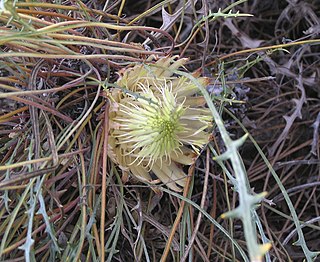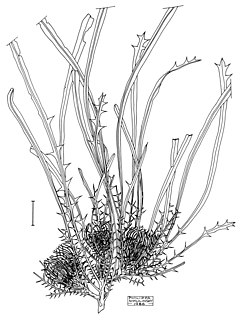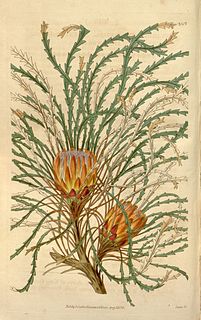Banksia biterax is a species of dense shrub that is endemic to Western Australia. It has hairy stems, deeply serrated leaves and spikes of up to 200 pale to dark brown flowers.

Banksia columnaris is a species of column-like shrub that is endemic to Western Australia. It has pinnatifid leaves with between five and eighteen lobes on each side, heads of pale yellow to purple flowers and usually only one or two follicles forming in each head.
Banksia densa is a species of column-like shrub that is endemic to Western Australia. It has deeply serrated to pinnatifid leaves, creamy yellow flowers in heads of up to seventy-five, and hairy follicles.
Banksia cypholoba is a species of dwarf, prostrate shrub that is endemic to Western Australia. It has pinnatipartite leaves with twenty-five to forty triangular lobes on each side, heads of about sixty brownish and yellow flowers and mostly glabrous follicles.
Banksia echinata is a species of shrub that is endemic to Western Australia. It has serrated leaves with nine to twenty-five sharply pointed, triangular teeth on each side, heads of about fifty pale yellow flowers and sparsely hairy follicles.
Banksia epimicta is a species of prostrate shrub that is endemic to a small area in the south-west of Western Australia. It has crowded, sharply pointed pinnatifid leaves, large heads of unpleasantly scented, creamy white and pale yellow flowers and a small number of follicles.

Banksia rufa is a species of prostrate shrub that is endemic to the south-west of Western Australia. It has broadly linear, pinnatifid or pinnatipartite leaves with between five and twenty lobes on each side, yellow, orange or brownish flowers in heads of forty or more, and glabrous, egg-shaped follicles.
Banksia glaucifolia is a species of shrub that is endemic to Western Australia. It has deeply serrated, wedge-shaped leaves with sharply pointed lobes, pale yellow flowers and follicles with hairy edges.

Banksia hewardiana is a species of openly branched shrub that is endemic to Western Australia. It has linear, serrated leaves with sharply pointed teeth, head of up to sixty lemon-yellow flowers and oblong follicles.

Banksia hirta is a species of shrub that is endemic to Western Australia. It has hairy stems, deeply serrated leaves, pale yellow flowers in heads of about one hundred and shining follicles. It is restricted to the Stirling Range National Park.
Banksia idiogenes is a species of tufted shrub that is endemic to Western Australia. It has hairy stems, deeply pinnatifid leaves, distinctive, scented, red and white flowers in heads of about eighty, later several glabrous, egg-shaped follicles in each head.
Banksia lepidorhiza is a species of prostrate shrub that is endemic to Western Australia. It has underground stems, linear pinnatipartite leaves with sharply pointed lobes, pink, cream-coloured and yellow flowers in head of about thirty and egg-shaped follicles. It is only known from near Woodanilling.

Banksia mimica, commonly known as summer honeypot, is a species of prostrate shrub that is endemic to Western Australia. It has wedge-shaped leaves with sharply-pointed teeth on the sides, yellow flowers in heads of up to fifty and oblong, hairy follicles.
Banksia pallida is a species of column-shaped shrub that is endemic to the south-west of Western Australia. It has densely hairy stems, linear leaves with three to five serrations on each side, pale yellow flowers in heads of up to eighty and egg-shaped to elliptical follicles.

Banksia bella, commonly known as the Wongan dryandra, is a species of dense shrub that is endemic to a restricted area of Western Australia. It has narrow, deeply serrated leaves covered with white hairs on the lower surface, heads of yellow flowers and few follicles in the fruiting head.

Banksia heliantha, commonly known as oak-leaved dryandra, is a species of shrub that is endemic to Western Australia. It has hairy stems, serrated, egg-shaped to wedge-shaped leaves, golden yellow flowers and partly woolly follicles.

Banksia strictifolia is a species of bushy shrub that is endemic to Western Australia. It has serrated, linear leaves with sharply-pointed teeth on both sides, creamy yellow flowers in heads of between forty-five and eighty-five, and egg-shaped to more or less spherical follicles.

Banksia subpinnatifida is a species of bushy shrub that is endemic to the southwest of Western Australia. It has more or less linear, pinnatipartite leaves with sharply-pointed teeth on the sides, golden yellow flowers in heads of about sixty, and glabrous, elliptical follicles.

Banksia tenuis is a species of shrub that is endemic to the southwest of Western Australia. It has pinnatifid, serrated or smooth-edges leaves, golden brown and cream-coloured flowers in heads of about fifty-five and glabrous, egg-shaped follicles.
Banksia trifontinalis is a species of openly-branched shrub that is endemic to the southwest of Western Australia. It has broadly linear, coarsely serrated, sharply pointed leaves, pale yellow flowers in heads of about sixty, and oblong to egg-shaped follicles.











